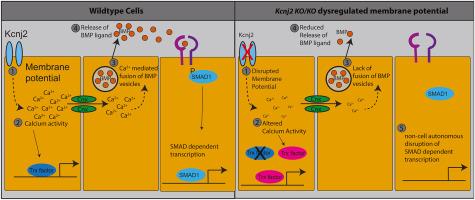Kcnj2调控胚胎小鼠腭架电活动诱导的基因网络。
IF 2.1
3区 生物学
Q2 DEVELOPMENTAL BIOLOGY
引用次数: 0
摘要
腭裂会干扰饮食、呼吸和说话,给人类带来巨大的痛苦。胎儿暴露于许多靶向离子通道的药物会增加腭裂的发生率。了解离子通道如何促进腭发育可以预防腭裂。离子通道调节细胞的电学特性。我们发现小鼠胚胎腭间充质细胞像神经元一样具有电活性。在神经元中,电活动自主调节转录细胞并调节化学信号的分泌。我们发现电活动调节小鼠腭间充质细胞骨形态发生蛋白(BMP4)的分泌。下一个重要的步骤是确定电活动如何影响转录以控制腭发育。钾离子通道Kcnj2 (Kcnj2KO/KO)的缺失改变了上颚间充质细胞的电活动,导致小鼠腭裂。我们比较了来自Kcnj2KO/KO和野生型E13.5小鼠前腭架的单细胞RNA测序数据集,以确定电活动如何自主影响细胞和周围细胞的基因表达。我们的数据显示Kcnj2KO/KO改变了钙诱导的转录因子和下游效应物的网络。这些数据还表明,Kcnj2的缺失会影响表达Kcnj2的细胞外的基因表达,这与BMP信号的破坏一致。本文章由计算机程序翻译,如有差异,请以英文原文为准。

Kcnj2 regulates electrical activity-induced gene networks in embryonic mouse palate shelves
Cleft palate interferes with eating, drinking, breathing, and speech, causing significant human suffering. Fetal exposure to many medications that target ion channels increases the incidence of cleft palate. Cleft palate could be prevented by understanding how ion channels contribute to palatal development. Ion channels regulate the electrical properties of cells. We discovered that the mouse embryonic palate mesenchymal cells are electrically active, like neurons. In neurons, electrical activity regulates transcription cell-autonomously and regulates the secretion of chemical cues. We discovered that electrical activity regulates secretion of bone morphogenetic protein (BMP4) from mouse palate mesenchymal cells. The next important step is to determine how electrical activity affects transcription to control palate development. Loss of a potassium channel called Kcnj2 (Kcnj2KO/KO) alters electrical activity in palate mesenchyme cells and causes cleft palate in mice. We compared single cell RNA sequencing datasets from Kcnj2KO/KO and wildtype E13.5 mouse anterior palate shelves to define how electrical activity affects gene expression cell autonomously and in surrounding cells. Our data reveal that Kcnj2KO/KO alters a network of calcium-induced transcription factors and downstream effectors. These data also reveal that loss of Kcnj2 affects gene expression outside of the cells that express Kcnj2 consistent with disruption of BMP signaling.
求助全文
通过发布文献求助,成功后即可免费获取论文全文。
去求助
来源期刊

Developmental biology
生物-发育生物学
CiteScore
5.30
自引率
3.70%
发文量
182
审稿时长
1.5 months
期刊介绍:
Developmental Biology (DB) publishes original research on mechanisms of development, differentiation, and growth in animals and plants at the molecular, cellular, genetic and evolutionary levels. Areas of particular emphasis include transcriptional control mechanisms, embryonic patterning, cell-cell interactions, growth factors and signal transduction, and regulatory hierarchies in developing plants and animals.
 求助内容:
求助内容: 应助结果提醒方式:
应助结果提醒方式:


